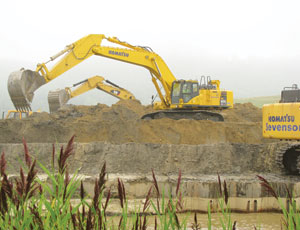One year after dikes failed at the Tennessee Valley Authority’s Kingston coal-fired powerplant near Knoxville, Tenn., and sent coal ash spilling over 300 nearby acres and into the Emory River, contractors have removed two-thirds of the river waste and are halfway through the $1-billion cleanup. But the agency and regulatory officials are struggling with how to prevent a repeat of the Dec. 22, 2008, catastrophe.

Tom Kilgore, TVA’s CEO, told a congressional subcommittee this month that he expects cleanup and removal of all 5.4 million cu yd of ash to take until 2013. But because removal of 3 million cu yd of river ash is deemed “critical,” that work is scheduled for completion this spring.
Under a $60-million contract, Sevenson Environmental Services, Niagara Falls, N.Y., is operating a 14-in. dredge and a 20-in. dredge 24 hours per day, six days a week, to clear the river. Crews are removing 15,000 cu yd of ash per day and so far have removed 1 million cu yd. About 400 to 500 workers, including about 100 Sevenson employees, are on site every day. Pasadena, Calif.-based Jacobs Engineering Group Inc. is managing cleanup for TVA. So far, the project has 69 different contracts, officials say.
“The typical environmental dredging is much different in terms of size and scope,” says Leo Francendese, on-site coordinator for the U.S. Environmental Protection Agency, which is overseeing the cleanup. “We’re using what would be the equivalent of river dredging in terms of size and cutter head,” he says, adding that crews are doing work “aggressively” but without impact on the environment.
Dredged material, primarily water containing about 13% silt-sized coal-ash particles, is dewatered through basic gravity-settling techniques and rail-shipped by Atlanta-based MACTEC Inc. to landfills in Georgia and Alabama. For now, ash is not being sold for reuse, officials say. Because some ash was impounded for decades and was from various types of coal, it may have higher toxicity, according to published reports.
EPA is expected to rule on new regulations for handling coal-ash waste before year’s end, a ruling that could affect how such waste is handled nationwide. This spring, after cleanup is approved for other spill-affected areas, TVA will start removing remaining ash and begin restoring the entire area to its pre-spill condition. An EPA spokesman says it will not levy penalties against TVA as long as the federal utility meets stated remediation milestones. A state Dept. of Environment and Conservation spokeswoman says Tennessee officials are now assessing damage costs.
In addition to cleanup, Kilgore says a $1.5-billion to $2-billion construction effort will be required to stabilize and clean up coal-ash storage at TVA’s 11 coal-ash storage facilities in Alabama and Tennessee, including Kingston. That work is being led by Stantec Consulting, Edmonton, Alberta, which has done a geotechnical analysis of the sites. Stantec found seven systemwide problems, including stacks of ash built over ash ponds and construc- tion of tall, unsupported weir struc-tures.
A Dec. 1 report by a Tennessee DEC advisory board determined that the staged construction used to build ash ponds is not the best choice. “If you are going to plan a structure to hold a 100-foot-high pile of sludge and water,” says Bruce Tschantz, a board member and professor emeritus of civil-environmental engineering at the University of Tennessee.
One of the board’s missions was to review a root-cause analysis report performed for TVA by AECOM Technology Corp., Los Angeles, but its members will not issue an opinion on that analysis. However, the board says dams, not ponds, should be used to hold coal-ash waste. Other experts agree, including Barry Thacker, a professional engineer and president of Geo-Environmental Associates, Knoxville. He says if ponds had been designed and monitored as dams, the accident would not have happened.
TVA is taking “a long, hard look at ourselves,” Kilgore says, with a focus on its engineering staff and construction procedures. At Stantec’s recommendation, key TVA staffers are being trained to recognize ash-pond failure modes.

Post a comment to this article
Report Abusive Comment